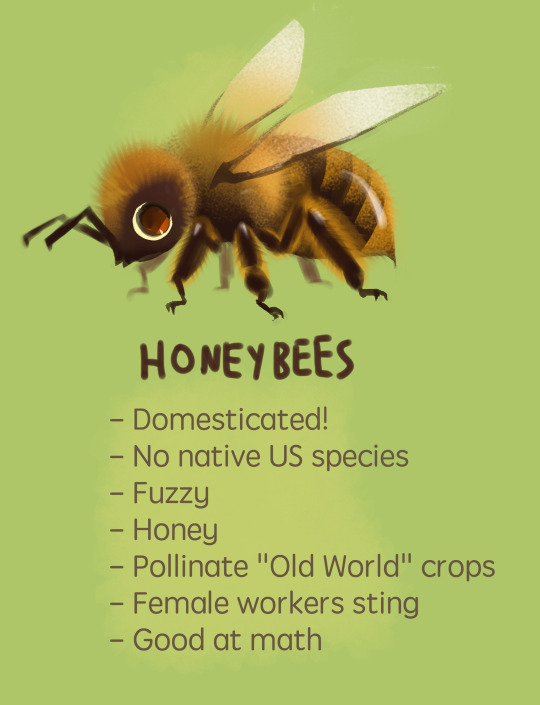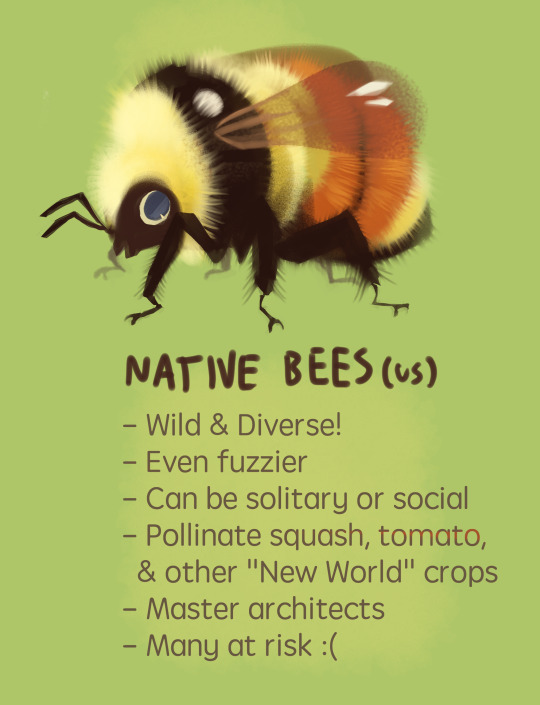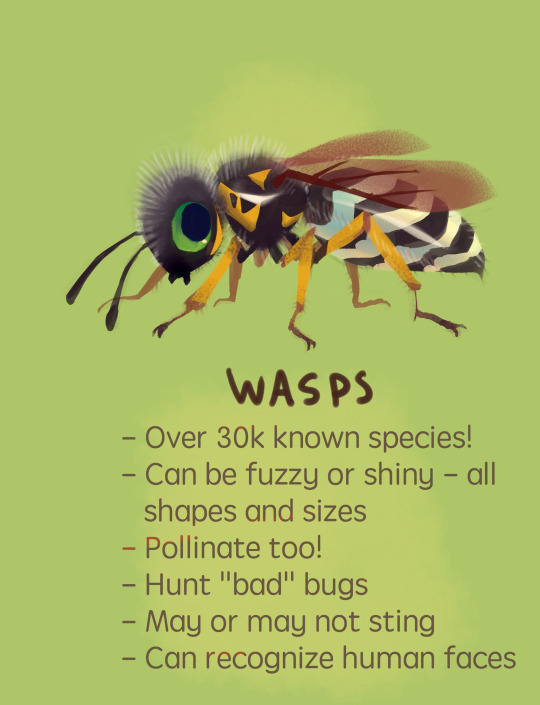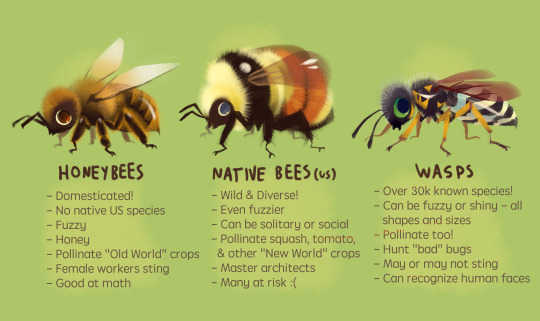Photo




I’ve been seeing some WASP NEGATIVITY lately so just a reminder that insects are important and interesting whether you find them “cute” or not. Which btw wasps are cute actually but anyways… (also sorry for the US-centrism)
65K notes
·
View notes
Note
wasps land on me all the time!! sometimes wasps that have been foraging too much will come up to me and rub the excess pollen on me, or just lie down on my arm for a small rest after their long flights!! yellowjackets and hornets especially take a liking to me :)
Can you think of any reasons that wasps would let a human pick them up and land on a human willingly? Because Idk how to explain it I just know that for as long as I can remember wasps have really liked me. And it’s just wasps, bees and other insects don’t like me at all they have normal reactions of fear/agitation when I attempt to interact with them.
You are the newest and coolest Disney Royalty. Mammals and birds are overrated. In all honesty though? *shrugs* You just have the magic touch I guess. Which is an awesome super power. Too bad The Wasp is taken as a superhero name.
:( If anyone has any similar experiences or info to share, please do so! I’m super curious who else has Royal Disney Blood. LOL!
16 notes
·
View notes
Photo

A Field Guide to the Oxiginene: Page 2, 2MYAB
The Eusocial Vespidae have begun to explode in population, with Vespid hives (all nests have grown to a point to be considered hives) topping off population at nearly 50,000 individuals during a major bloom. Hives of the Apoidea can reach up at nearly 600,000 individuals, which grows the size of the physical hive to massive sizes, in some cases almost 10 meters side to side, with swarming events becoming more and more common as populations grow faster than the hives can.
#spectember#speculative evolution#speculative zoology#speculative biology#speculative insect evolution#spec evo#insect#insects#wasp#bees#art#my art
12 notes
·
View notes
Photo

A Field Guide to the Oxinigene Page 1. The Skatharidae, 2MYAB
Certain Vespids, the Skatharidae (Beetle Wasps) have seemed to have dropped the vegetarian lifestyle of adult wasps and begin to become fully carnivorous, developing more aggressive behavior and larger mandibles in order to accommodate their new lifestyle. Their counted nests cap out at 50 members at this time, as the individuals grow to be about 7-9 inches long
#spectember#spectember2020#spec evo#speculative evolution#speculative zoology#speculative biology#speculative insect evolution#speculative entomology#A Field Guide to the Oxinigene#insect#insects#wasps#wasp#wasp evolution#skatharidae#art#my art#insect art#artists on tumblr
4 notes
·
View notes
Text
1MYAB
The plant life of the planet adapted rapidly to the elevated oxygen, and within a million years large forests of ferns and jungle trees began to take over the equator, creating a hot, humid environment across the entire planet, with temperature averaging 80 degrees fahrenheit, and bottom out around 60 in the coldest days of winter. In the polar regions however, deciduous forests made for a far more habitable environment for small surviving mammals and birds, free from insect competition and sweltering heat
With the planet becoming more and more habitable by the generation, more and more wasp larvae begin to survive to adulthood, with this massive increase in population, and the increase in temperature as the planet became more humid, the wasp population o longer had to worry about overwinter population, as the equator, where most species survived, rarely fell below 60 degrees. Certain hives of the Apoidea began to grow massive, with the population peaking at 300,000 in a good year. The Formicidae also began to expand their colonies, and due to their multiple queens could house populations of over 1,000,000 individuals, most of them smaller than half and inch, but some growing to an inch in length. From here on out the wasps will be treated as five distinct groups, the Eusocial Vespids, Apids, and Ants, the small nested carnivore Skatharidae, known for hunting the many beetles that roamed the forest floor, and the parasitic Ichneumonidae.
The dermestid beetles that quickly radiated into many niches split into 3 distinct groups quickly after the extinction. The beetles that began to consume the bones and exposed marrow of the wiped out creatures became the Osteoridae. the beetles that continued their flesh eating habits became the Dermestidae, and the beetles that began to consume fallen leaves and dead plant matter became the Phteridae. Certain species of Phterids started to develop small colonies of only a few hundred, normally at the bases of large clumps of ferns or large surviving trees
#spectember#speculative zoology#speculative biology#speculative evolution#spec evo#speculative insect evolution#insect#insects#wasps#bees#ants#After Bloom
7 notes
·
View notes
Text
once i get access to my tablet ill be posting my spectember updates as more of a field guide!! going through the evolution of these species almost like a biologist living through these millions of years, i think itll be fun
1 note
·
View note
Text




Plz admire this huge fuckin carpenter bee going to town on some flowers. What a big baby ilysm
16 notes
·
View notes
Text
an update on spectember schedules
ok so my every other day schedule wont work cuz of sunday so i think that im going to do it every Monday, Tuesday, Friday, and Sunday, with sunday being like, a special day where i recap the week with an evolutionary tree, little doodles, and updates on mammals and reptiles post-bloom
0 notes
Text
0 MYAB
A massive algal bloom covering nearly all remaining freshwater, and much of the coastal waters surrounding the split continent of Eurasia causes a much worse K/PG mass extinction, and is seen as a continuation of the event, as it was directly caused by the warming of the planet following the dust winter caused by the asteroid impact. This massive bloom starves most fish and marine life of oxygen in the waters surrounding the bloom, but massively increases atmospheric oxygen to 40% for a total of 1 million years. However in this time period many ferns and trees adapted to, and began to thrive in high oxygen environments, leading to massive forest growth in bands across the planet, generally within the tropics, however a few temperate rainforests began to sprout up in the later half of the blooms million, and the continuation of a high, yet slightly lower atmospheric oxygen level (AOL) of 35%
99% of all animal species were wiped out following the K/PG extinction, a major group of survivors were small holdouts of the Vespoidea, already evolved into the most primitive bees and ants. The few survivors of the extinction stayed small for the first million years, as food was scarce, and surviving past the larval stage was rarer. Due to this scarcity the queens began to lay more and more eggs to increase the chances of the eggs making it to adulthood. This expansion of Vespid populations is still fairly slow at this point in time. Certain species of solitary Vespids however, began laying less eggs and began to tend more to their eggs and beginning the adaptation of parental behavior.
Few species of Coleoptera, specifically the very first Stag Beetles, survived the extinction, and began to thrive in the high oxygen environment, while still small at this time, they are markedly larger than they were before. Small beetles in the family Dermestidae also survived the extinction, and thrived off of the thousands of corpses left behind, leading to a massive boom in their population, and rapid radiation into detritivore niches.
Many small flies also began radiating into the leftover detritivore niches, with little biological adaptation this early after the extinction event.
#spectember#speculative evolution#speculative zoology#speculative biology#speculative insect evolution#ill add images in future updates once i have access to my tablet :)#insects#bugs#insect#bug#wasp#bee#beetle#dermestid beetle#vespoidea
3 notes
·
View notes
Text
im doing a spectember!
every other day ill be posting an update to my speculative world starting tomorrow! but the general overview of the world is as follows: Everything is the same until the K/PG (Cretaceous-Paleogene) extinction, which did happen (no dinosaurs here, sorry), but shortly after the main chaos of it all died down a massive algal bloom occurred, wiping out most remaining fish, reptiles, and mammals, and bumping the atmospheric oxygen level to that of the carboniferous, 35%, beginning the Oxyginene Era ill be mainly talking about insects and plants, as thats what i like, know about, but once a week i’ll write/draw small updates for the other major groups that survived the algal bloom! the years will be denoted with (T,M)YAB (Thousand, Million) Years after Bloom and ill be moving time forward in generally 1 million years per update, so 3 million years a week! I hope i can keep a schedule!
2 notes
·
View notes
Note
weaver ants will also thunk the larvae against the leaf to get it to produce silk! lil thwack thwack like a stapler
Cursed ant fact, go!
weaver ants make nests by sticking leaves together with silk!

it’s architecturally really impressive, especially since one leaf is to an ant what a giant chunk of corrugated steel is to you.
so how do they do it? ants aren’t particularly known for their silk-making ability.
well, first the weaver ants form living chains to literally winch the leaves down into position...

...aaand they they rely on some good old-fashioned child labor to make things stick.

see, there’s one form of ant that IS known to make silk- their larva! baby ants normally spin cocoons for themselves when they get ready to turn into an adult ant, just like caterpillars do.
but if you happen to be a weaver ant larva, you instead donate that silk to the good of the colony by becoming a living spot-welder. they use all their silk in the production of nests, and don’t make cocoons of their own at all!
though no one will ever know their opinion on child-labor laws, because they’re ants.

6K notes
·
View notes
Text

@goat-yells-at-everything submitted: We have reached full Cogsworth ladies and gentlemen! I repeat! We have reached full Cogsworth!
Hes about twice as big as he was when I submitted him last week! If it wasn’t for youre id I wouldn’t even think he was the same bug!
Cogsworth!!! Get a load of that wheel. Glad to see this lad is absolutely thriving 🖤
52 notes
·
View notes
Video
[7/8/20] Swamp Cicada (Nymph), Neotibicen tibicen.
Found lots of exoskeletons, but this is the first time I’ve found one of the live nymphs.
74 notes
·
View notes
Video
Calognathus chevrolati (Tenebrionidae)
[source]
4K notes
·
View notes


